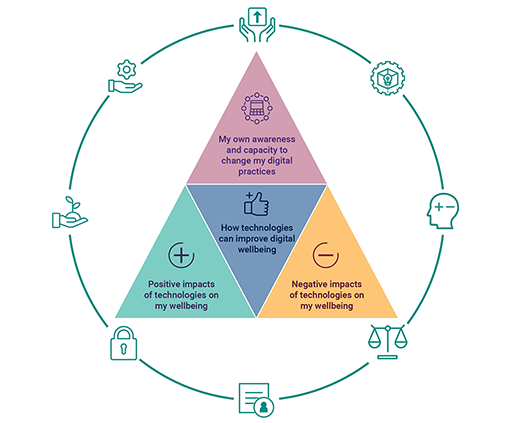3.1.2 Your digital wellbeing
It was mentioned earlier that this course would examine wellbeing from a digital perspective, informed by the ‘Digital Wellbeing’ element of Jisc’s individual digital capabilities framework (Jisc, n.d.). Let’s look at this now.
Digital wellbeing is a term used to describe the impact of technologies and digital services on people’s mental, physical, social and emotional health.
Hybrid working, communication and digital collaboration can sometimes be challenging or demanding, and can affect your wellbeing.
It can be more difficult to develop organisational culture and build trust in hybrid working environments. Culture and trust are built through human connections, and, as humans, we have had to adjust to be able to develop these, both in person and in a digital virtual world.
As new ways of working evolve, it is worth asking questions such as: Have we adapted? How is it different now? If you think about how you work with your colleagues and your organisation in a post-COVID-19 context, you may find that your culture and trust naturally evolved as you adapted to hybrid ways of working. As hybrid working evolves, you may find that you and your colleagues are going into the office more, either due to organisational requirements or personal choice. For teams that have a hybrid approach, it is important to remember that some people will still be remote workers and ensuring that they continue to feel connected is important. Considering how you work with your team to make the most effective use of digital technologies can help with this.
Activity 4 The impact of digital technologies on your wellbeing
Look carefully at the diagram below.
- Consider how technologies can affect your digital wellbeing at work by identifying positive and negative impacts they have had, either from your own experience or those you’ve observed in colleagues.
- What capacity do you think you have to change your digital practices to improve your wellbeing?
You can make some notes in the box below.
Discussion
Jisc’s ‘Digital Identity and Wellbeing’ capability includes the capacity to:
- look after personal health, safety, relationships and work–life balance in digital settings
- use digital tools in pursuit of personal goals (e.g. health and fitness) and to participate in social and community activities
- act safely and responsibly in digital environments
- manage digital workload, overload and distraction
- act with concern for the human and natural environment when using digital tools.
How does this relate to your response to this activity?
Jisc (2019b) have stated that for individuals in an education context, digital wellbeing ‘links closely to their personal and social digital wellbeing and to developing and managing their professional and personal digital identities and footprints.’
Now watch the video in which Sas Amoah, Digital Media Producer at The Open University, shares how he manages his digital wellbeing.

Transcript
The Jisc model focuses on four contexts of your digital wellbeing – social, personal, learning and work – that can help you consider areas you might want to focus on. These are listed in Table 3.
| Digital wellbeing context | Positives | Negatives |
|---|---|---|
| Social |
|
|
| Personal |
|
|
| Learning |
|
|
| Work |
|
|
Some of the recommendations Jisc suggests to help improve your digital wellbeing are:
- Ask for training and support on the digital systems and tools relevant to your role, so that you can use them effectively and safely
- Take time to explore and understand your digital preferences and needs
- Consider the impact of digital activities on your own health and the health of others
- Manage your digital workload by learning how to use tools effectively, managing your emails and avoiding distractions
- Create a positive digital identity.
Many of these will be explored in Sections 4 and 5 of this course.

